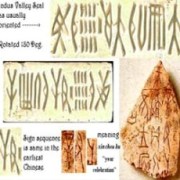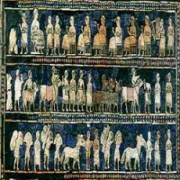Ancient India Civilizations

Harappa and Mohenjo-DaroIndia as they say is not a country but a confluence of various civilizations.
Civilization is the most advanced stage of human social development and organization.
There are two distinct civilizations in India.
Indus Valley Civilization in Ancient India
The first is bronze based civilization called Indus valley civilization and the second is iron based civilization called Vedic civilization.Indus valley civilization that flourished from about 2500 BC to 1700 BC in India qualifies all the parameters of the definition of a civilization.
It’s most important cities, Harappa and Mohenjo-Daro besides Kalibangan tells the story of the first Indian civilization that developed around the river Indus.
These cities had features which made them unique included brick and well-planned streets, pottery drainage ditches, large granaries, and a large bath for ritual cleansing.
There were small, two-room structures to large houses with two-storied with courtyards.Most of the major buildings were constructed on raised platform and were made from brick with each city perhaps having 35,000 people at their height.
The people of Indus valley civilization traded with Sumer and Sumerian merchants referred them as Meluhha. They also traded with Mesopotamia and Egypt. They sent merchant ships to the island of Tilmun in the Persian Gulf.

Indus civilization trade The main items of exports included surplus grain, pottery vases, inlays, ivory combs, pearls, precious woods, and semi-precious stones. Indus Valley farmers grew wheat, barley, field-peas, melons, sesame, and dates. They also domesticated humped cattle, short-horn cattle, and buffaloes, and perhaps even pigs, camels, horses, and donkeys. The land was full of water buffalo, tigers, elephants, rhinoceros and enormous forests.
In valley civilization was the first to turn cotton into yarn and weaving the yarn into cloth. Cotton was first developed around 2000 B.C. Their unique script consisted of 400 symbolic pictures, but has not yet been deciphered.
The lack of public inscriptions or written historical documents has hindered other information about the Indus valley civilization.
The Indus civilization civilisation was Bronze Age civilization. It declined around 1900 BC under pressure from a new people, the Aryans that saw the emergence of Vedic Civilisation that was the Iron Age civilization.
Aryan Civilization in Ancient India

The Indo-European Aryans The Aryans entered the northern part of India from Central Asia by 1500 BC. The Aryans re kindled the light of a new civilization on the banks of the river Ganges as they spread across to some other parts of the country, and settled in different regions of North and West India.
The Aryan tribes were called Gana meaning a collection of people. The chief of each tribe held all the powers that were passed on from father to son. By 1,000 BC Aryans had learned to use iron and in course of time they went on to became farmers.It’s because of farming activity a more ordered and settled society evolved.
The Aryans became the priests, rulers and warriors, free peasants and merchants. They ate meat as well as vegetables. They also introduced horse and raced chariots. They prayed to numerous god and goddesses. The caste system has its beginning during this time. It was based on occupations. Education was oral and writing was done on bark and leaves.

Indus civilization The Hindu religion also evolved at this time and the compilation of the Vedas occurred. Initially the four Vedas were orally passed on from one generation to the other, but later they were written down. The Rig Veda, the main religious and socio-economic text of Hindus was written between 1300 and 1100 BC.
The people in the Vedic period lived in straw and wooden huts. Some homes were made of wood, during the epics Period. The social life cantered on Yagna meaning s a ritual of sacrifice.
They learned to farm rice and by 600 BC rice cultivation was flourishing in India.With a more settled and ordered society trade and commerce also flourished. Life in towns evolved again and writing was re-invented. By 600 BC a highly civilized society had emerged in India if not better then at least equal to Indus valley civilization.
After the Iron Age Vedic Civilisation, people of different races and cultures entered India and settled down bringing with them diverse ideas, beliefs and traditions and in course of time amalgamated within the Indian civilization.
The idea of Indian civilization continued to flourish as India transcended its journey from Ancient to Medieval to Modern times.
Contribute More Facts